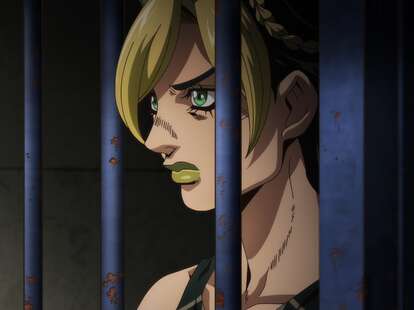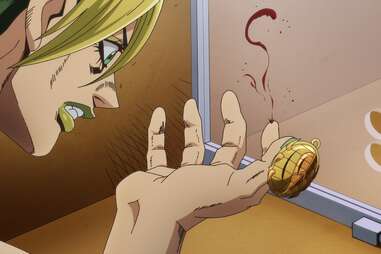'JoJo's Bizarre Adventure' Returns with the Long-Awaited 'Stone Ocean'
Despite some production flaws, Netflix's 'Stone Ocean' is as wild as ever.

A season that feels incredibly long-awaited, Stone Ocean is something of a finale for a narrative that JoJo’s Bizarre Adventure has been telling for the better part of a decade. The story begins hundreds of years in the past, beginning with Jonathan Joestar and his adoptive brother and nemesis Dio Brando, a vampire. Even after he is killed by Jonathan’s descendant (Stardust Crusaders protagonist Jotaro Kujo), Dio (also known as DIO) continues to haunt the Joestar family with the events he set in motion. And now, his one-time acolytes seek revenge against the Joestar bloodline.
Enter Jolyne Cujoh, Jotaro’s estranged daughter, who begins the season framed for murder and sentenced to 15 years in a Florida state prison. Soon after she arrives, malevolent forces move against her and her family and she’s forced to use her newfound Stand powers (named “Stone Free”) to fend for herself. In addition to the power of Stands, Stone Ocean introduces “DISCs”, essentially magic CDs that contain the soul. They sort of become this season’s MacGuffin, with Jolyne spending her time in prison chasing the one with the power to steal them. That foe, the wielder of the Stand "Made in Heaven," is a more existentially terrifying foe that JoJo has ever had—one that also introduces the new complication of Stand Users with multiple abilities.
Though it continues on with the story of the Joestar bloodline (something signified by a trademark star birthmark) as established in Phantom Blood, Stone Ocean follows on in the visual style and tone of Diamond is Unbreakable and Golden Wind. By that I mean that instead of the more typically macho appearances of Parts 1–3, where most high schoolers are two meters in height and look like Kenshiro from Fist of the North Star, Hirohiko Araki’s characters have since taken on sleeker, frequently more beautiful androgynous appearances, like Greek sculptures come to life. That change—which began around Part 4: Diamond is Unbreakable—is now perhaps among the most striking things about JoJo, along with the dramatic poses. While not expressly about queer culture, you can hardly call the queerness of the show subtext; even with some more overt elements from the manga cut out, it’s as prominent as the heart-shaped chest window on Bruno Bucciarati’s suit.
The other thing is its wild variance in tone. One minute, it talks around some surprisingly heavy subject matter and nasty gore, and in the next, a tiny bug man hisses “Goo… Goo… Dollsss!!” as it chases a tiny Jolyne. Other examples include moments where a ghost child dressed like a baseball player gives cryptic, prophetic warnings, or a sniper smuggles in gun parts through blocks of cheese.
Speaking of Diamond is Unbreakable—like how that season scaled the series down from the globetrotting adventures of Stardust Crusaders—Stone Ocean focuses in on Jolyne’s plight in the Green Dolphin prison in Florida (called “The Aquarium” by its inmates), following on from Golden Wind’s journey across Italy. Of course, it later expands out to a much larger scale, but these early episodes are mostly set in and around the institution. It picks up the quick tempo of Golden Wind, compressing a number of chapters from the manga into a shorter amount of time so the show hits the ground running even by comparison to an already quickly paced prior season.

Even among the other JoJo’s Bizarre Adeventures, Stone Ocean’s story is one of a constant existential terror, beginning with its protagonist distraught over the time she’ll lose facing a 15-year prison sentence—in Florida no less. Framed for murder, Jolyne is fleeced by her lawyer (who looks like a fawn), who throws her under the bus in order to rescue her boyfriend Romeo, and Jolyne is sent to the Green Dolphin prison. Not long after Jolyne “don’t call me Jojo” Cujoh is in custody, she receives a mysterious package from her father Jotaro (the protagonist of Stardust Crusaders, now the world’s most fashionable marine biologist), which grants her the power of the Stand (later to be named Stone Free). As with most things in Stone Ocean, this happens in a rather horrifying and—well, bizarre fashion, and her hands immediately unravel like thread.
To be upfront, if you liked any previous JoJo outings, high chances are you’ll also like Stone Ocean, which doubles down on everything beloved about JoJo: off-kilter humor, the absurd mind games and one-upmanship, and the completely out-of-left field end credits song choices (last season “Freekn’ U” by Jodeci, this season… Duffy?). Araki’s playfulness with popular culture is as delightful as ever. The show is filled with loud references to his favorite acts—indeed, someone sings Jolyne’s name, mimicking Dolly Parton’s hit song “Jolene” in the second episode. Numerous characters and their Stands are named after favored bands, artists, and songs (which, as in previous seasons, lead to some hilarious copyright dodging, like “Marilyn Manson” becoming “Mary Lynn Manson”).
What also returns is the series’ pet themes of strained patriarchal relationships, ones that clash with the characters’ sense of social responsibility, having to align themselves with parents they don’t trust (or even know, in the cases of Giorno Giovanna and Josuke Higashikata). Jolyne is estranged from Jotaro by the same qualities that made him a fun character to watch in past seasons—his cool competence and unflappable demeanor translating to his daughter as a lack of concern. The relationships of JoJo’s deep-rooted family tree remain as mutable and as fascinating as ever.
With its new mystery and the isolated space of the prison, the battles continue to unfold as a series of mind games and deductions before being settled with brute force, but something that came into even sharper focus was the introduction of the power of the Stand (spiritual energy manifested in the world with powers and appearance unique to the user; but only other Stand users can see Stands). Also wonderful is its idiosyncratic color choices and its graphic art style, with a number of intentionally flattened layouts and the overt placement of sound effects that evoke the pages of a comic book sprung to life. Yes, this sounds obvious and a bit silly written down, but JoJo relishes those roots more than plenty of other manga adaptations. The music is also as great as ever, starting with a Paramore-esque opening number and culminating with the wailing guitars that score Jolyne’s “fuck around and find out” theme music.
These elements are as fine as ever but, homered to something like Golden Wind, the animation is left wanting. While JoJo’s direction and focus on dramatic poses and intentionally flattened compositions often moved it away from “fluidity,” the animation feels stiffer than is normal for the show. Stone Ocean feels like it could have used more time to be polished.
The difference isn’t always apparent but there’s a noticeable uptick in the amount of CG animation used as well as frequent inconsistency with the drawings of characters, more so than feels normal for a show such as this. It still looks good enough, thanks to the aforementioned color direction, poses and character designs. Though this is only speculation, but it feels as if production was a bit rushed to accommodate Netflix’s binge model of releasing its acquired television shows.
As with other shows dumped on streaming this way, it’s a shame that the show’s big moments feel a little more unceremonious—you simply leap from one part to the next. That said, it looks great when it counts, and it’s especially fun when it highlights the idiosyncrasies of Jolyne’s powers such as in the magnificent ninth episode. This is to say that even with these caveats, Stone Ocean still thrives on the strength of its aesthetic and its story, its voice acting and the ever-dynamic, hilariously odd-kilter stylings of its original author.